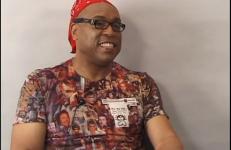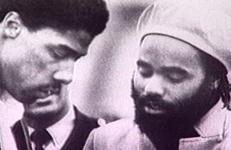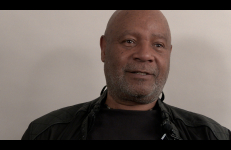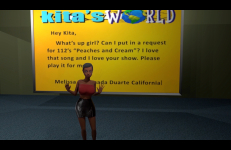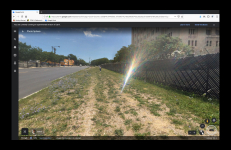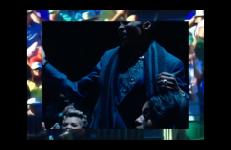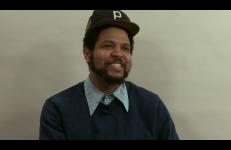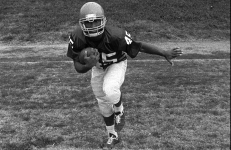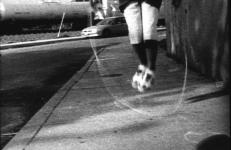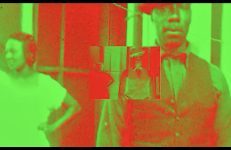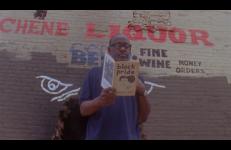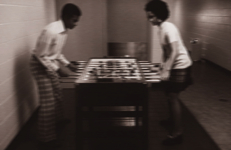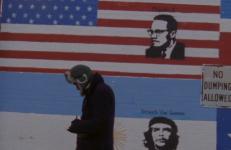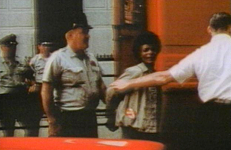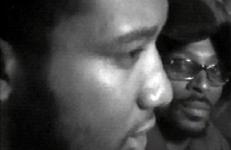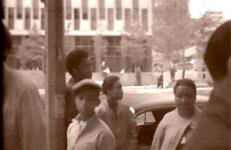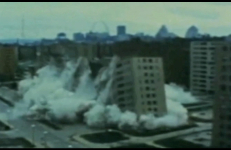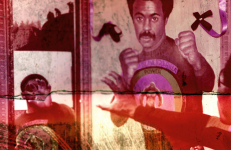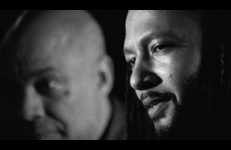In this interview, American artist, independent curator, writer, and experimental filmmaker, Vaginal Davis reflects on her initiation into the punk rock and art scenes of Los Angeles during the 1980s and 90s, her stylistic influences, and her ongoing efforts to theorize queerness and visuality. Caught between the opposing poles of Hollywood classicism and the rawness of punk, Davis defines her unapologetically gender-bending, campy, and at times aggressively critical performances as scenarios, rather than spectacles or entertainment.
African-American
Deathrow Notebooks is structured around an interview with Mumia Abu-Jamal, a political prisoner who is on death row in Pennsylvania. Former president of the Association of Black Journalists, Abu-Jamal is a writer and creator of widely-broadcast radio programs who continues to write from prison. He was accused of killing a police officer, and in 1982 was convicted in a trial that contained many irregularities. To date, all of his appeals have failed.
Deathrow Notebooks is structured around an interview with Mumia Abu-Jamal, a political prisoner who is on death row in Pennsylvania. Former president of the Association of Black Journalists, Abu-Jamal is a writer and creator of widely-broadcast radio programs who continues to write from prison. He was accused of killing a police officer, and in 1982 was convicted in a trial that contained many irregularities. To date, all of his appeals have failed.
Paul D. Miller (b. 1970) is a conceptual artist, writer, and musician better known as DJ Spooky. A popular and prolific recording artist, he has collaborated with Ryuichi Sakamoto, Butch Morris, Yoko Ono, Thurston Moore (of Sonic Youth), Kool Keith, and Killa Priest (of Wu Tang Clan). Miller’s work uses a wide variety of digitally created music as a form of postmodern sculpture.
Emory Douglas is a political artist and activist, producing revolutionary art for important political movements. He joined the Black Panther Party in 1967 and was the Minister of Culture for the Party, and created powerful illustrations and collages for the movement and the Party’s Black Panther Newspaper until the Party dissolved in the early 1980s. In this interview with Sampada Aranke, Douglas speaks about joining the Black Panthers as well as the creation and social and political impact of the Black Panther Newspaper.
Dream Nightmare is from Martine Syms’ Kita’s World series. Kita enacts the performances of everyday life in a hyper-digitized world. The character’s roles range from meditation guru to cultural commentator, and she speaks directly to questions of consciousness within the systems of labor, race, technology, and institutional failure. To the cognitive dissonance of Siri mishearing her speech, to the terror of (mis)representation, to the instinct to reconnect with nature.
Frenzied voices on the Chicago Police Department’s scanner call for squad cars and reprisals during the 2020 uprising in response to the murders of George Floyd, Breonna Taylor, and Ahmaud Arbery, as Google Earth tracks the action through simulated aerial views of urban spaces and the vast Cook County Department of Corrections, the country’s third-largest jail system. In Christopher Harris’s Dreams Under Confinement, the prison, and the street merge into a shared carceral landscape.
At one point in END-LESSsestina, several men linking arms are made to walk, blindfolded, into a pool of water. We see thrashing and an expanse of blue, and finally, a lone tennis ball bobbing largely in the frame. Leading into this scene we hear a sports commentator contend, “it’s not just her out there, she’s representing America.” This line repeats itself throughout the video like a refrain; a pervasive echo of the American media’s criminalization of Serena Williams’ celebratory dance at the 2012 Olympics.
In this interview, African American filmmaker and DJ Ephraim Asili (b. 1979) discusses his upbringing, education, and creative process. Born and raised around the city limit of Philadelphia, Asili’s childhood and adolescence were imbued with hip hop music, Hollywood movies and television.
Kent Merritt waxing poetically about being one of the first four Black scholarship athletes at the University of Virginia.
This title is only available on Can You Move Like This: Black Fire.
Kent Merritt waxing poetically about being one of the first four Black scholarship athletes at the University of Virginia.
This title is only available on Can You Move Like This: Black Fire.
Fifeville is a film about a neighborhood in Charlottesville, Virginia. It focuses on the details, gestures, and material life of the citizens of Fifeville as they communicate their understandings of the neighborhood’s changing landscape. Although Fifeville is set in Charlottesville, it could be Any Black Community Experiencing Gentrification, USA, 21st Century.
Co-director: Corey D.B. Walker. Crew: bh103a.
In this 23-minute single-channel video, Campbell reconfigures scenes from archival 16mm film footage recorded by Solomon Sir Jones in the mid-1920s, film that documents the everyday lives of Black communities in Oklahoma, an area that once boasted over fifty Black townships during Reconstruction. The film documents Black self-determination in light of the erasure and displacement of Black communities across the United States, such as the Greenwood District in Tulsa Oklahoma—the site of the 1921 Tulsa Race Massacre, that persists today.
Fluid Frontiers is the fifth and final film in the series entitled The Diaspora Suite, exploring Asili’s personal relationship to the African Diaspora. Shot along the Detroit River, Fluid Frontiers explores the relationship between concepts of resistance and liberation, exemplified by the Underground Railroad, Broadside Press, and artworks of local Detroit Artists.
Based on a photograph taken in the mid 1970s of two African Americans playing foosball.
This title is only available on Can You Move Like This: Black Fire.
Based on a photograph taken in the mid 1970s of two African Americans playing foosball.
This title is only available on Can You Move Like This: Black Fire.
The Diaspora Suite
Filmed on location in Harlem (NY) and Ethiopia, Forged Ways oscillates between the first person account of a filmmaker, a man navigating the streets of Harlem, and the day to day life in the cities and villages of Ethiopia.
In the words of activist Dhoruba Bin Wahad, “Historical and social events are subject to almost instant censorship by those who have better access and control over the medium of communication. It is important that there exist people skilled in the use of the technological instruments of communication who will seek out the real truth behind the headlines and tell it for all to see, know, and hear.”
In the words of activist Dhoruba Bin Wahad, “Historical and social events are subject to almost instant censorship by those who have better access and control over the medium of communication. It is important that there exist people skilled in the use of the technological instruments of communication who will seek out the real truth behind the headlines and tell it for all to see, know, and hear.”
The Videofreex conducted this interview with Fred Hampton, the Deputy Chairman of the Illinois chapter of the Black Panther Party, in October 1969, just over a month before he was killed by the Chicago police.
Rare footage of a September 1970 rally honoring the late Fred Hampton, Deputy Chairman of the Illinois chapter of the Black Panther Party. One of the speakers leads the audience in a call and response.
Futures for Failures is a double narrative of failure: architectural and social. Archival footage from a demolition of the Pruitt-Igoe building in St. Louis manifests as the materialization of modernity’s failure. Meanwhile, an intimate voiceover recounts a moment of laughter erupting during a stranger’s funeral, staging anachronous conversation between the disappeared and the disappearing.
Go-Rilla Means War is a filmic relic of gentrification featuring 35mm film salvaged from a now demolished Black Civil Rights Theater in Bedford-Stuyvesant, Brooklyn. After finding the film unfinished and un-canned on the floor of The Slave Theater, Campbell collaborated with the unknown director (presumably amateur filmmaker Judge John Phillips who owned the Slave Theater) to finish the film.
Two Black University of Virginia hospital employees talking about the job site in a Albemarle County speakeasy.
This title is only available on Can You Move Like This: Black Fire.
Two Black University of Virginia hospital employees talking about the job site in a Albemarle County speakeasy.
This title is only available on Can You Move Like This: Black Fire.




